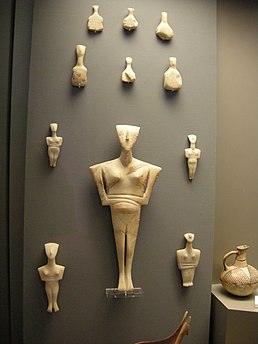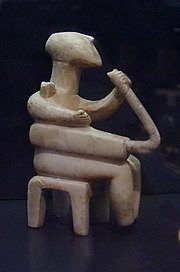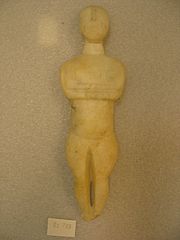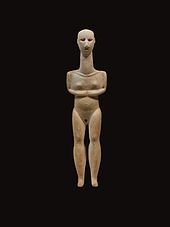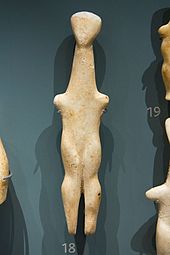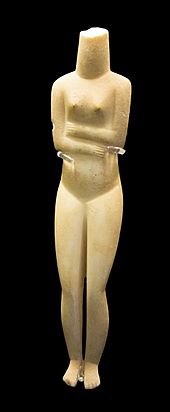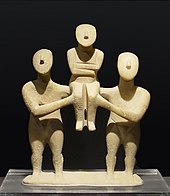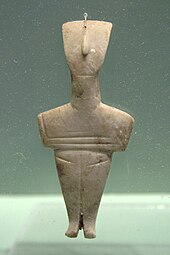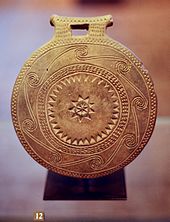
The Cyclades are an island group in the Aegean Sea, southeast of mainland Greece and a former administrative prefecture of Greece. They are one of the island groups which constitute the Aegean archipelago. The name refers to the archipelago forming a circle around the sacred island of Delos. The largest island of the Cyclades is Naxos, however the most populated is Syros.

Sculpture is the branch of the visual arts that operates in three dimensions. Sculpture is the three-dimensional art work which is physically presented in the dimensions of height, width and depth. It is one of the plastic arts. Durable sculptural processes originally used carving and modelling, in stone, metal, ceramics, wood and other materials but, since Modernism, there has been almost complete freedom of materials and process. A wide variety of materials may be worked by removal such as carving, assembled by welding or modelling, or moulded or cast.
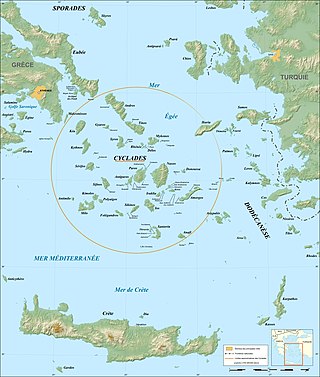
Cycladic culture was a Bronze Age culture found throughout the islands of the Cyclades in the Aegean Sea. In chronological terms, it is a relative dating system for artifacts which serves as a roughly contemporary dating system to Helladic chronology and Minoan chronology (Crete) during the same period of time.

A Venus figurine is any Upper Palaeolithic statue portraying a woman, usually carved in the round. Most have been unearthed in Europe, but others have been found as far away as Siberia and distributed across much of Eurasia.

Amorgos is the easternmost island of the Cyclades island group and the nearest island to the neighboring Dodecanese island group in Greece. Along with 16 neighboring islets, the largest of which is Nikouria Island, it comprises the municipality of Amorgos, which has a land area of 126.346 square kilometres and at the 2011 census had a population of 1,973.
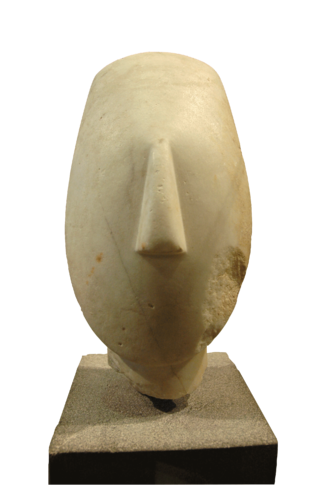
Aegean art is art that was created in the lands surrounding, and the islands within, the Aegean Sea during the Bronze Age, that is, until the 11th century BC, before Ancient Greek art. Because is it mostly found in the territory of modern Greece, it is sometimes called Greek Bronze Age art, though it includes not just the art of the Mycenaean Greeks, but also that of the non-Greek Cycladic and Minoan cultures, which converged over time.

Frying pans is the descriptive nickname for a type of Early Cycladic II artifacts from the Aegean Islands around 2700-2200 BCE. They are flat circular disks with a "handle", and usually made from earthenware, but sometimes stone. They are found especially during the Cycladic Grotta-Pelos and Keros-Syros cultures. Their purpose remains unknown, although they are usually interpreted as prestige goods.

Tau-, Psi- and phi- type Greek terracotta figurines date back to 1450–1100 BC in Mycenaean Greece. They were typically small, made of terracotta, although a group of ivory figurines has been found, and were found in tombs, shrines and settlement areas. They are classified by their shape and a resemblance to the Greek letters of tau (τ), psi (ψ) and phi (Φ), according to a typological system created by Arne Furumark in 1941.

Sculpture in the Indian subcontinent, partly because of the climate of the Indian subcontinent makes the long-term survival of organic materials difficult, essentially consists of sculpture of stone, metal or terracotta. It is clear there was a great deal of painting, and sculpture in wood and ivory, during these periods, but there are only a few survivals. The main Indian religions had all, after hesitant starts, developed the use of religious sculpture by around the start of the Common Era, and the use of stone was becoming increasingly widespread.

Terracotta figurines are a wide range of small figurines made throughout the time span of Ancient Greece, and one of the main types of Ancient Greek pottery. Early figures are typically religious, modelled by hand, and often found in large numbers at religious sites, left as votive offerings. Psi and phi type figurines are two very early and simple types, dating as far back as 1400 BCE.

Delphi Archaeological museum is one of the principal museums of Greece and one of the most visited. It is operated by the Greek Ministry of Culture. Founded in 1903, it has been rearranged several times and houses the discoveries made at the Panhellenic sanctuary of Delphi, which date from the Late Helladic (Mycenean) period to the early Byzantine era.

Minoan art is the art produced by the Bronze Age Aegean Minoan civilization from about 3000 to 1100 BC, though the most extensive and finest survivals come from approximately 2300 to 1400 BC. It forms part of the wider grouping of Aegean art, and in later periods came for a time to have a dominant influence over Cycladic art. Since wood and textiles have decomposed, the best-preserved surviving examples of Minoan art are its pottery, palace architecture, small sculptures in various materials, jewellery, metal vessels, and intricately-carved seals.

Xochipala is a minor archaeological site in the Mexican state of Guerrero, whose name has become attached, somewhat erroneously, to a style of Formative Period figurines and pottery from 1500 to 200 BCE. The archaeological site is much later and belongs to the Classic and Postclassic eras, approximately 200–1400 CE.

Phylakopi, located at the northern coast of the island of Milos, is one of the most important Bronze Age settlements in the Aegean and especially in the Cyclades. The importance of Phylakopi is in its continuity throughout the Bronze Age and because of this, it is the type-site for the investigation of several chronological periods of the Aegean Bronze Age.
The Sounion Kouros is an early archaic Greek statue of a naked young man or kouros carved in marble from the island of Naxos around 600 BCE. It is one of the earliest examples that scholars have of the kouros-type which functioned as votive offerings to gods or demi-gods, and were dedicated to heroes. Found near the Temple of Poseidon at Cape Sounion, this kouros was found badly damaged and heavily weathered. It was restored to its original height of 3.05 meters (10.0 ft) returning it to its larger than life size. It is now held by the National Archaeological Museum of Athens.

Ancient Greek art stands out among that of other ancient cultures for its development of naturalistic but idealized depictions of the human body, in which largely nude male figures were generally the focus of innovation. The rate of stylistic development between about 750 and 300 BC was remarkable by ancient standards, and in surviving works is best seen in sculpture. There were important innovations in painting, which have to be essentially reconstructed due to the lack of original survivals of quality, other than the distinct field of painted pottery.
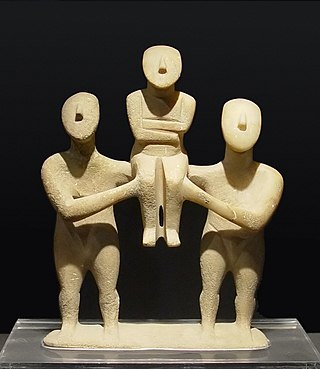
The Keros-Syros culture is named after two islands in the Cyclades: Keros and Syros. This culture flourished during the Early Cycladic II period of the Cycladic civilization. The trade relations of this culture spread far and wide from the Greek mainland to Crete and Asia Minor.
The Ralaghan idol, also known as the "Ralaghan figure", is a late Bronze Age anthropomorphic, carved wooden figure found in a bog in the townland of Ralaghan, County Cavan, Ireland. It is held by the National Museum of Ireland.
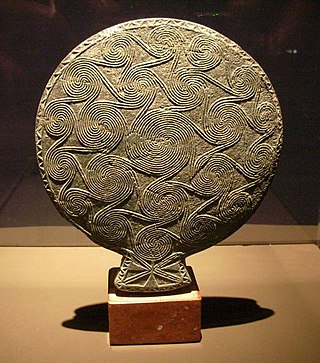
The Cycladian frying pan is an ornately decorated stone object of the type nicknamed as frying pans, from the Bronze Age Cycladic civilization. It dates to the Early Cycladic period, between the 27th and 24th centuries BC. The find spot is unknown, except that it originated on the Cycladic island of Naxos. The item derived from an illegal excavation and was acquired in 1975 by the Baden State Museum in Karlsruhe. On 6 June 2014 it was repatriated to the National Archaeological Museum of Athens, Greece.

Saliagos is an islet in the Greek island group of Cyclades. It is the first early farming site and one of the oldest settlements of the Cycladic culture.
